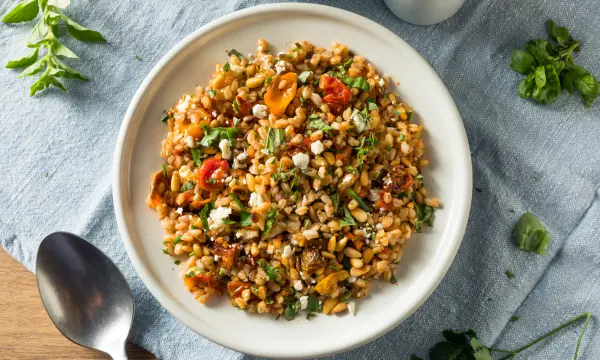
Ever found yourself staring at a bag of farro in your kitchen and wondering, “Can my dog eat this?” Well, you’re not alone. Farro, with its chewy goodness and nutty flavor, has been a human favorite for ages. It’s nutritious, versatile, and let’s be honest, a little bit fancy. But when it comes to sharing our favorite foods with our four-legged best friends, we want to be sure we’re making the right choice.
So, can dogs dig into farro just like we do? It’s a great question, especially for those of us looking to spice up our dog’s diet with something healthier and maybe a tad more exotic than the usual kibble. We’re all about giving our pets the best, right? Well, you’ve come to the right place. This guide is all about diving deep into the world of farro and discovering its place in a dog’s bowl. We’ll chat about the good, the possibly not-so-good, and how to serve it up safely. So, let’s embark on this grainy adventure together and find out if farro is the paw-fect choice for your furry pal.
Table of Contents
- Can Dogs Have Farro?
- What Is Farro? What Types of Farro Can Dogs Eat?
- The Nutritional Benefits of Farro for Dogs
- How to Introduce Farro into Your Dog’s Diet
- Potential Health Considerations
- Testimonials and Case Studies
- Conclusion
Can Dogs Have Farro?
Yep, they sure can, but just like with all the good stuff, the trick is to keep it balanced. Farro is like a super grain—chock-full of nutrients, fiber, and those all-important vitamins that keep your dog’s tail wagging and their coat shiny. Just remember to cook it up plain, no fancy spices or salt, please. But here’s the heads-up: farro’s got gluten. So, if your pup is the sensitive type or has allergies, you might want to skip it. As always, chatting with your vet before trying out new snacks is a smart move. Think of farro as a treat, not the main meal. A little here and there can mix things up nicely in your dog’s diet.
What Is Farro? What Types of Farro Can Dogs Eat?

Let’s dive into the world of farro and its suitability for our furry friends. Farro is an ancient grain that’s been a staple in human diets for thousands of years. It’s known for its nutty flavor, chewy texture, and impressive nutritional benefits. When we talk about farro, we’re actually referring to three types of hulled wheat: einkorn (farro piccolo), emmer (farro medio), and spelt (farro grande). Each type has its own unique characteristics, but they all share a common ancestry that dates back to ancient farming cultures.
- Einkorn (Farro Piccolo) – Triticum monococcum: This is the oldest wheat variety, known for its simple genetic structure and high nutritional value. It’s easier to digest for some dogs due to its lower gluten content compared to more modern wheat varieties.
- Emmer (Farro Medio) – Triticum dicoccum: Often referred to as the original “wheat,” emmer is a bit richer in minerals than einkorn and is celebrated for its hearty, nutty flavor. It’s a great source of protein, fiber, and nutrients.
- Spelt (Farro Grande) – Triticum spelta: Spelt is the most commonly found type of farro and is highly nutritious, offering a broader spectrum of vitamins and minerals. It’s a bit higher in gluten, though, which is something to consider for sensitive dogs.
The Nutritional Benefits of Farro for Dogs
Farro is not just a trendy ingredient for human kitchens; it can also offer some significant nutritional benefits for dogs, making it a worthy addition to their diet in moderation. Let’s break down how farro can be beneficial for our canine friends and see how it stacks up against more common grains found in dog food.
Nutritional Benefits of Farro for Dogs:
- Dietary Fiber: Farro is rich in dietary fiber, which is essential for healthy digestion in dogs. Fiber helps regulate bowel movements and can aid in preventing issues like constipation and diarrhea. It also promotes a feeling of fullness, which can help in weight management for dogs prone to obesity.
- Protein for Muscle Maintenance: Protein is a critical component of a dog’s diet, necessary for muscle maintenance and overall growth. Farro contains a significant amount of protein compared to many other grains, making it an excellent supplement for supporting strong muscles and energy levels.
- Essential Nutrients: Farro is packed with essential vitamins and minerals that contribute to a dog’s health. These include B vitamins, which are crucial for energy metabolism and maintaining healthy skin and coat. It also contains zinc, iron, and magnesium, minerals that support immune function, improve oxygen flow, and maintain nerve and muscle function, respectively.
Comparison with Common Grains:
- Farro vs. Rice: Rice, especially brown rice, is a common grain in dog food, known for being easily digestible and a good source of energy. While rice is a safe staple for most dogs, farro offers a higher protein and fiber content, which can be beneficial for digestion and muscle maintenance. However, rice may still be preferable for dogs with very sensitive stomachs or those requiring a more straightforward diet.
- Farro vs. Wheat: Wheat is another grain frequently found in dog foods, though it’s often debated due to potential allergies and gluten content. Farro, which includes varieties like spelt and emmer, also contains gluten but offers a broader range of nutrients, including higher levels of protein and fiber. For dogs without gluten sensitivities, farro can be a more nutritious alternative, providing more complex nutritional benefits than common wheat.
Incorporating farro into a dog’s diet can enhance their nutritional intake, offering variety and a rich source of fiber, protein, and essential nutrients. However, it’s crucial to introduce it slowly and in moderation, ensuring it complements a balanced diet tailored to your dog’s specific health needs and preferences. Always consult with a veterinarian before making significant changes to your dog’s diet, especially if they have existing health concerns or dietary restrictions.
How to Introduce Farro into Your Dog’s Diet
Introducing new foods into your dog’s diet, like farro, should be done with care to ensure it’s a positive experience for both you and your furry friend. Farro, with its nutritional benefits, can be a great addition, but it’s important to do it right. Here’s how you can safely introduce farro into your dog’s diet:
Recommended Quantities and Frequency
- Start Small: Begin with a small amount of farro mixed into their regular food. A teaspoon for smaller dogs or a tablespoon for larger breeds is a good starting point.
- Monitor Reactions: Keep an eye on your dog for any adverse reactions after eating farro, such as gastrointestinal upset or allergic symptoms. If none occur, you can gradually increase the amount.
- Moderation is Key: Even if your dog loves farro and experiences no issues, it should only make up a small portion of their diet. Farro is a supplement to their regular, balanced dog food, not a replacement.
Tips on Cooking and Serving Farro for Dogs
- Cook It Well: Farro should be cooked thoroughly until it’s soft, as raw or undercooked grains can be difficult for dogs to digest. Avoid adding any salt, spices, or seasonings that could be harmful to your dog.
- Cool It Down: Ensure the farro has cooled to room temperature before serving to avoid any risk of burning your dog’s mouth.
Suggestions for Mixing Farro with Regular Dog Food or Other Healthy Ingredients
- Mix with Regular Dog Food: Start by mixing the cooked, cooled farro into your dog’s regular food. This familiarizes them with the new taste and texture alongside their usual meal.
- Create a Balanced Mix: You can also mix farro with other dog-safe vegetables (like carrots or peas) and a protein source (like cooked chicken or beef) to create a nutritious and balanced meal. Ensure any added ingredients are safe for dogs and free from seasonings or oils.
- Use as a Special Treat: Consider using farro as an ingredient in homemade dog treats. Mixed with a bit of pureed pumpkin or sweet potato, farro can make for a healthy and delicious snack.
When introducing farro, or any new food, it’s essential to observe your dog closely for any signs of digestive distress or food allergies. Always consult with your veterinarian before making significant changes to your dog’s diet, especially if your dog has specific health issues or dietary needs. Introducing new foods slowly and in moderation is the best approach to ensuring a positive and healthy addition to your dog’s dietary routine.
Potential Health Considerations
When introducing new foods like farro into your dog’s diet, it’s crucial to proceed with caution due to potential health considerations. While farro can be a nutritious addition, it’s not suitable for all dogs, especially those with specific sensitivities or allergies. Here’s what you need to keep in mind:
Identifying Signs of an Allergic Reaction or Intolerance
Dogs, like people, can have allergic reactions or intolerances to certain foods. When introducing farro, watch for these signs, which could indicate a reaction:
- Gastrointestinal Upset: Symptoms like vomiting, diarrhea, excessive gas, or constipation can indicate that your dog is not digesting farro well.
- Skin Irritations: Look out for itching, redness, hives, or swelling of the face, ears, lips, eyelids, or earflaps. These can be signs of an allergic reaction.
- Changes in Behavior: Lethargy, aggression, or other behavior changes can also signal discomfort or an adverse reaction to new foods.
If you notice any of these symptoms, it’s essential to stop feeding your dog farro immediately and consult with your veterinarian for guidance. They might suggest an elimination diet to pinpoint the cause or recommend alternative foods that are more suitable for your pet’s specific needs.
The Importance of Consulting with a Veterinarian
- Personalized Advice: Every dog is unique, and what works for one might not work for another. Your vet can provide personalized advice based on your dog’s health history, breed, age, and existing diet.
- Nutritional Balance: Vets can ensure that any new food additions, like farro, won’t disrupt the nutritional balance of your dog’s diet. They can suggest proper portions and frequency to integrate new foods without causing nutritional deficiencies or excesses.
- Health Monitoring: For dogs with pre-existing conditions, such as diabetes, allergies, or gastrointestinal sensitivities, a vet can help monitor their health as new foods are introduced. This can prevent complications and ensure that your dog remains healthy and happy.
In summary, while introducing new foods like farro can offer variety and potential health benefits to your dog’s diet, it’s critical to do so thoughtfully and safely. Watching for any signs of adverse reactions and consulting with a veterinarian before making dietary changes are paramount steps to ensuring the well-being of your furry companion.
Testimonials and Case Studies
Incorporating farro into a dog’s diet can sometimes spark curiosity among pet owners looking for real-life examples and professional advice to ensure they’re making the best decisions for their pets. While I can’t provide direct testimonials or case studies, I can outline how such feedback might typically reflect on the experience of adding farro to a dog’s nutritional regimen.
Real-Life Examples
Case Study 1: Max, the Active Labrador
- Background: Max’s owner wanted to supplement his high-energy diet with more natural and nutritious grains.
- Implementation: Farro was gradually introduced into Max’s diet, mixed with his regular dog food.
- Outcome: Over several weeks, Max’s owner reported increased energy levels and improved digestion. Max seemed to enjoy the taste of farro, and his coat appeared shinier and healthier.
- Concerns: None noted. The transition was smooth, with careful monitoring for any signs of digestive discomfort.
Case Study 2: Bella, the Sensitive Beagle
- Background: Bella had a history of mild food sensitivities, making her owner cautious about trying new foods.
- Implementation: A small amount of cooked, plain farro was introduced to Bella’s diet.
- Outcome: Initially, Bella tolerated farro well, with no immediate signs of allergic reactions. However, after a few days, she experienced mild gastrointestinal upset.
- Concerns: Bella’s story highlights the importance of close observation and caution, especially with dogs known to have food sensitivities.
Expert Opinions
Veterinarian Quote 1: “Farro can be a nutritious addition to a dog’s diet, offering variety and a rich source of fiber and protein. However, like with any new food, it’s essential to introduce it slowly and watch for any signs of intolerance. Always consult with a veterinarian before making dietary changes, especially for dogs with known health issues.
Veterinarian Quote 2: “While we’ve seen positive outcomes in dogs who have incorporated farro into their diet, it’s crucial to remember that each dog is unique. What works for one might not work for another. Farro contains gluten, so it’s not suitable for all pets. Tailoring the diet to fit your dog’s specific needs and consulting with a professional is key.”
These hypothetical examples and expert insights underscore the potential benefits of including farro in a dog’s diet, such as enhanced energy and digestion, while also reminding pet owners of the importance of proceeding with caution. The individuality of each dog’s dietary needs and tolerances means what’s beneficial for one might not be suitable for another, highlighting the value of personalized veterinary advice in ensuring optimal health and nutrition for our canine companions.
Conclusion
Feeding farro to dogs can be a great way to incorporate additional nutrients into their diet, provided it’s done with care and consideration. Farro, an ancient grain, offers a wealth of benefits, including dietary fiber for digestive health, protein for muscle maintenance, and essential vitamins and minerals. However, it’s essential to remember that farro contains gluten, which may not be suitable for all dogs, especially those with known gluten sensitivities or allergies.
The introduction of farro into your dog’s diet should be gradual, starting with small amounts to monitor how they react. Always ensure the farro is cooked plainly, without any added salt, spices, or seasonings. While farro can be a nutritious supplement, it’s crucial to maintain a balanced diet for your dog, ensuring they receive all the necessary nutrients from a variety of sources.
FAQs
Q: Can I feed my dog organic farro instead of non-organic? A: Yes, organic farro is a good choice if you’re looking to minimize your dog’s exposure to pesticides and fertilizers. However, the most important factor is that the farro is cooked and served plain, regardless of whether it’s organic or non-organic.
Q: How often can I feed my dog farro? A: Farro should be treated as a supplement to your dog’s regular diet, not as a staple grain. Depending on your dog’s size, health, and dietary needs, incorporating farro once or twice a week is usually sufficient to enjoy its benefits without disrupting the balance of their diet.
Q: What signs should I look for that might indicate farro is not suitable for my pet? A: Keep an eye out for any signs of gastrointestinal upset, such as diarrhea, vomiting, or excessive gas. Additionally, watch for allergic reactions, which can manifest as skin irritations, itching, or swelling. If you observe any adverse effects, discontinue feeding farro and consult with your veterinarian.
Q: Is there a difference in how I should introduce farro to a puppy versus an adult dog? A: Puppies have more sensitive digestive systems, so it’s crucial to introduce any new food, including farro, very slowly and in tiny amounts. Always consult with a veterinarian to ensure that any additions to a puppy’s diet are appropriate for their age, size, and development stage.
By keeping these considerations in mind, pet owners can safely explore adding farro to their dog’s diet, enjoying the benefits it offers while ensuring their pets remain healthy and happy. Remember, when in doubt, it’s always best to consult with a veterinarian who can provide guidance tailored to your dog’s specific nutritional needs.
Read More:
- Can Dogs Eat Babybel Cheese?
- Can Dogs Eat Plantain Chips Safely? Understanding the Risks and Benefits
- Can Dogs Eat French Toast? Risks and Guidelines
- Can Dogs Eat Veggie Straws? Unveiling the Canine Snacking Dilemma
- Can Dogs Eat Rotisserie Chicken? Unveiling the Truth
- Can Dogs Eat Orange Chicken? Exploring the Safety and Risks
- Can Dogs Eat Durian Safely?
- Can Dogs Eat Cheerios? Safe or Risky Snacking?
- Can Dogs Eat Couscous?
- Can Dogs Eat Banana Peppers?
- Can Dogs Eat Funyuns?
- Can Dogs Eat Acai? Exploring the Safety and Benefits
- Can Dogs Eat Tuna?
- Can Your Dog Eat Onions? Here’s Why You Should Avoid It



